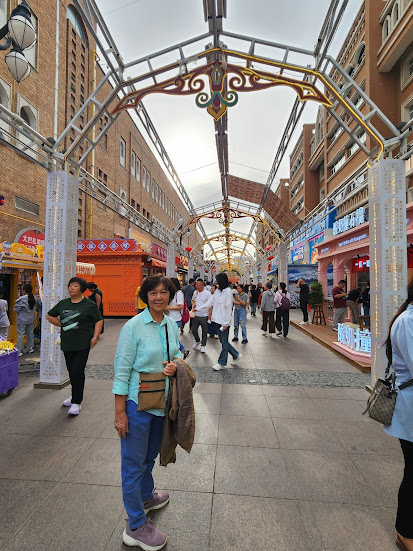Day 12, 03.06.2025, we checked out from our hotel in Jiadengyu and began our journey southward, traveling toward our next destination - Wuerhe Ghost City. Along the way, we stopped in Burqin for lunch, a river town nestled near the Irtysh River.
 |
| Hotel where we stayed in Jiadengyu. |
Burqin turned out to be the
westernmost point we had reached on this entire journey from
Xian, having traveled roughly
3,500Km by road. That realization alone was striking. Even more surprising, however, was the discovery that the coffee I ordered at a quaint outlet named
Jeremiah after lunch had been imported from
Malaysia - a small, unexpected connection to home in such a far-flung place.
After our break in Burqin, we continued southeast for another 320Km, arriving at Wuerhe Ghost City (乌尔禾魔鬼城) around 4.45pm. This vast desert landscape is famous for its haunting Yardang landforms - strange, wind-eroded shapes sculpted over millions of years.
 |
| Entrance to the Wuerhe Ghost City. |
These rock formations rise like natural sculptures from the barren earth, some resembling ancient fortresses, beasts, or abandoned vessels stranded in an ocean of sand. With the afternoon sun casting long shadows over the rippling terrain, the place felt like a set from a science fiction epic - utterly surreal.
 |
The man-shaped stone perched atop a massive rock outcrop
is said to resemble Xuanzang, the Buddhist monk who
journeyed to India. |
 |
| This is said to resemble "The Great Sphinx of Giza". |
***************************************************
For the more adventurous - and those undeterred by the searing desert heat - camel rides are readily available, offering another way to explore the unusual landscape.
****************************************************
The site owes its name, “Ghost City” (鬼城), to the howling winds that sweep through the valleys and formations, producing eerie, unearthly sounds. These ghostly acoustics have inspired not only folklore but also filmmakers, with several Chinese movies and TV series choosing this dramatic location as their backdrop.
Beyond its haunting beauty, the Ghost City is also a paleontological site of global interest. Numerous dinosaur fossils have been excavated in the region, with protected fossil zones marking the area's rich prehistoric history. It’s a place where natural history and myth converge.
We boarded the sightseeing shuttle, which followed a designated route through the park, stopping at major vantage points. The terrain was harsh and exposed, and the afternoon heat was intense, radiating off the desert floor and adding to the otherworldly feel of the environment.
If there’s one lasting impression of Wuerhe Ghost City, it’s the sense of being transported to a forgotten world - a place shaped by wind, time and legend, offering a dramatic and unforgettable contrast to the alpine lakes of Kanas and Tianchi and the verdant grasslands of Hemu.
**************************************************
We were originally scheduled to stop at the final station, known as
"Dinosaur Valley" (恐龙谷) or
"Dinosaur Park" (恐龙园). Unfortunately, due to a mix of possible tour fatigue and general disinterest from some members of the group, the tour leader was persuaded to skip the stop and continue on. For me, it was a moment of genuine regret.
This particular site features numerous life-sized dinosaur sculptures dramatically placed among the Yardang formations, along with informative displays that shed light on the area's rich prehistoric significance. A visit there would have offered a more vivid and tangible glimpse into the region’s dinosaur-era past - a fitting finale to this ancient landscape of Wuerhe Ghost City.






































































